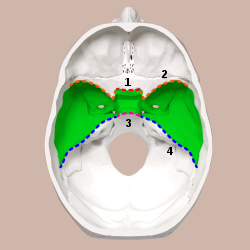Anatomy of the Middle Cranial Fossa:
- Formed by the sphenoid bones and temporal bones
- Lodges the temporal lobes and the pituitary gland
- Deeper than the anterior cranial fossa
- Narrow medially and widens laterally
- Separated from the posterior cranial fossa by the clivus and petrous crest
Features of the Middle Cranial Fossa:
- Middle part presents the chiasmatic groove and tuberculum sellae
- Chiasmatic groove ends at the optic foramen
- Anterior clinoid process is directed backward and medialward
- Sella turcica contains the pituitary gland and middle clinoid processes
- Carotid groove lodges the cavernous sinus and internal carotid artery
Lateral Parts of the Middle Cranial Fossa:
- Support the temporal lobes of the brain
- Marked by depressions for the brain convolutions
- Traversed by furrows for the middle meningeal vessels
- Furrows begin near the foramen spinosum
- Apertures include the superior orbital fissure, foramen rotundum, foramen ovale, foramen Vesalii, and foramen spinosum
Clinical Significance of the Middle Cranial Fossa:
- Middle fossa craniotomy is used to remove acoustic neuromas
- Acoustic neuromas grow within the internal auditory canal
- Temporal bone is involved in the procedure
References and Additional Information:
- Grays Anatomy, 20th edition, page 190
- Grays Anatomy: The Anatomical Basis of Clinical Practice, 42nd edition
- Grays Clinical Anatomy, Cranial Fossae
- Additional images available
- External links to Wikimedia Commons
The middle cranial fossa is formed by the sphenoid bones, and the temporal bones. It lodges the temporal lobes, and the pituitary gland. It is deeper than the anterior cranial fossa, is narrow medially and widens laterally to the sides of the skull. It is separated from the posterior cranial fossa by the clivus and the petrous crest.
| Middle cranial fossa | |
|---|---|
 Superior view of the skull base. Middle cranial fossa shown in green. 1: Sphenoidal limbus (anterior margin of the chiasmatic groove) | |
 Base of the skull. Upper surface. (Middle cranial fossa is the centermost of the three indentations, in pink and yellow.) | |
| Details | |
| Identifiers | |
| Latin | fossa cranii media |
| MeSH | D035301 |
| TA98 | A02.1.00.049 |
| TA2 | 452 |
| FMA | 54369 |
| Anatomical terminology | |
It is bounded in front by the posterior margins of the lesser wings of the sphenoid bone, the anterior clinoid processes, and the ridge forming the anterior margin of the chiasmatic groove; behind, by the superior angles of the petrous portions of the temporal bones and the dorsum sellae; laterally by the temporal squamae, sphenoidal angles of the parietals, and greater wings of the sphenoid. It is traversed by the squamosal, sphenoparietal, sphenosquamosal, and sphenopetrosal sutures.